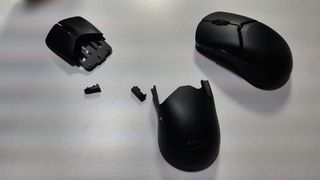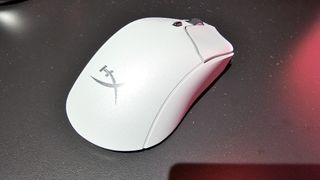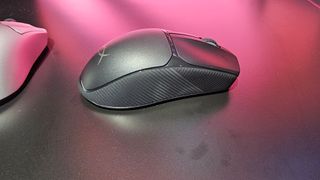HyperX wants you to print your own mouse
New modular mouse line will offer swappable parts in the box, plus a 3D print file for ultimate customization.

In a world of stripped-down, ultra-lightweight FPS-oriented gaming mice, HyperX is bringing something new (well, newish) to market: a lightweight, modular gaming mouse with eight interchangeable parts in the box and a downloadable 3D print file for further customization. The HyperX Pulsefire Saga will come in both wired and wireless versions, and will feature HyperX's current 26K optical sensor, the brand's own optical switches, and both mice will offer speedier polling rates — 8,000 Hz on the wired Saga, and 4,000 Hz wireless on the Saga Pro.
The brand is also, of course, updating its stripped-down, ultra-lightweight FPS-oriented Pulsefire Haste 2 line with a couple of new variations: the wireless Haste 2 Pro 4K, which will have — you guessed it — 4,000 Hz wireless polling; and the wireless Haste 2 S, which will have a magnesium alloy shell for "a balance of strength and agility" (whatever that means — it's a mouse, after all) and premium glass mouse skates installed (with spare PTFE skates in the box), but will have regular 1,000 Hz polling rate. The brand is also introducing a more budget-friendly wireless ambidextrous gaming mouse called the Pulsefire Fuse, which will run on a single AAA battery and feature dual wireless connectivity (2.4GHz wireless, Bluetooth) and have a Pixart PAW3311 sensor.

The HyperX Pulsefire Saga and Saga Pro are certainly not the first modular mice we've seen — partially modular customizable mice, such as the Mountain Makalu Max and the Razer Naga V2 Pro, are more popular than fully modular mice, of course. The Saga/Saga Pro will come with eight interchangeable parts in the box (which sounds like a lot but really isn't, as this includes four interchangeable thumb buttons). You'll get two primary mouse button pieces, two palm rest pieces, and two buttons for each of the two thumb buttons. It's not really the most exciting-looking mouse, even for modularity: the interchangeable palm rest pieces don't even change the shape of the mouse (both are ergonomically curved for a right hand).

But I suppose that's where the 3D printing aspect comes in — HyperX showed off several concept 3D-printed parts, including pieces with different shapes (such as adding a thumb rest), as well as pieces made of different materials and colors. The brand is offering a free 3D print file that customers can use to make and print their own custom mouse parts, so the possibilities are, theoretically, unlimited. I'm not entirely sure how many people are looking for something so unique that they'd rather make and print it themselves instead of just purchasing something that works, so we'll have to see how the market responds.
Spec-wise, the Saga and Saga Pro will both feature HyperX's current HyperX 26K optical sensor, which has a maximum resolution of 26,000 DPI, a maximum speed of 650 IPS, and can handle up to 50 G's of acceleration. Both mice will feature the brand's in-house optical mouse switches, and will have customizable RGB lighting — the wired Saga will have lighting in the scroll wheel and on a strip that divides the buttons from the palm rest, while the wireless Saga Pro will only have lighting in the scroll wheel. The Saga will offer polling rates of up to 8,000 Hz over its wired connection and will weigh a fairly lightweight 69g in all of the in-box customizations (this will change, obviously, if you use your own 3D-printed parts). The Saga Pro will offer wireless polling rates of up to 4,000 Hz over 2.4GHz wireless and will weigh 72g. HyperX says it will get up to 90 hours of battery life over 2.4GHz wireless using the standard 1,000 Hz polling rate, and up to 30 hours if you go for the 4,000 Hz.
Both mice will be available in March 2025; the Saga will cost $79.99, while the wireless Saga Pro will go for $119.99.

If modularity doesn't thrill you, no worries — HyperX is also adding a couple of new variations to its Haste 2 lineup. The Pulsefire Haste 2 Pro - 4K adds an optional 4,000 Hz wireless polling rate to the existing Haste 2 Wireless, as well as optical mouse switches. A minor update, but not a particularly surprising one given how many gaming mice have been pushing polling rate limitations (and yes, it's debatable whether most gamers will benefit or even notice the polling rate difference — but that's neither here nor there). The mouse otherwise appears to be the same as the original Haste 2 wireless: HyperX 26K optical sensor, lightweight 61g design, dual wireless connectivity, and PTFE mouse skates. HyperX says it will get up to 90 hours of battery life, presumably with a 1,000 Hz polling rate, which is close to the original Haste 2 wireless' 100 hour estimate.
The Haste 2 Pro - 4K will be available in January for $119.99, or $30 higher than the original Haste 2 wireless' retail price of $89.99.

If you're not here for high polling rates but you are here for aesthetic, the HyperX Pulsefire Haste 2 S is a fancier, premium version of the Haste 2 wireless, with a solid magnesium alloy shell and tempered glass mouse skates. It has translucent buttons (not magnesium, obviously) and will come in navy and silver colorways. Tom's Hardware editor Matt Safford liked the way the magnesium shell felt in his hand, even if it's technically a little heavier, at 64g, than the original 61g Haste 2 wireless. It will come with HyperX's glass mouse skates pre-installed, but HyperX will include extra PTFE skates for those who can't or don't want to use glass skates (they're not great for wood or glass surfaces, for example). HyperX will also sell its glass mouse skates separately on HP.com for $19.99.


The Haste 2 S is premium... only on the outside, it seems. Magnesium shell aside, it features the same 26K optical sensor and regular switches as the original Haste 2 wireless, as well as a standard 1,000 Hz polling rate. It will get better battery life — up to 120 hours over 2.4GHz wireless, versus the original's 100 hours, and will feature a quick-charge that will get you up to 18 hours of play time after 10 minutes of charging. Other specs include dual wireless connectivity and customizable RGB lighting in the scroll wheel. It will, of course, be expensive: $149.99 when it drops this March.
Stay On the Cutting Edge: Get the Tom's Hardware Newsletter
Get Tom's Hardware's best news and in-depth reviews, straight to your inbox.

Finally, HyperX's new Pulsefire Fuse wireless mouse is a budget-friendly, lightweight ambidextrous mouse for people who keep... dropping other lightweight ambidextrous mice.
Okay, it's actually — according to HyperX — "designed for palm grip users who are looking for a sleek frame." The mouse has an ambidextrous shape with Microline textured panels along the sides for extra grip, and features two customizable RGB zones. Like the brand's other budget-friendly wireless mice, the Fuse runs on one AAA battery, and will get up to 85 hours of battery life over a 2.4GHz connection (it will also have Bluetooth). The Fuse will feature a Pixart PAW3311 sensor, which has a maximum sensitivity of 12,000 DPI, a maximum speed of up to 300 IPS, and can handle up to 35 G's of acceleration. It will have Kailh switches in its primary buttons and a standard 1,000 Hz polling rate, and will weigh 75g with the battery installed (64g without).
The Pulsefire Fuse will be available in March for $49.99.

Sarah Jacobsson Purewal is a senior editor at Tom's Hardware covering peripherals, software, and custom builds. You can find more of her work in PCWorld, Macworld, TechHive, CNET, Gizmodo, Tom's Guide, PC Gamer, Men's Health, Men's Fitness, SHAPE, Cosmopolitan, and just about everywhere else.